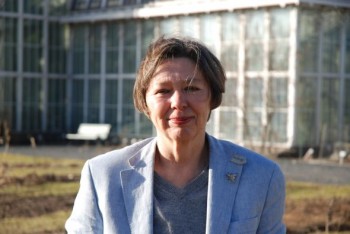Search results for "moomins/feed/www.booksfromfinland.fi/2014/10/letters-from-tove"
Juho Kotakallio: Hänen majesteettinsa agentit. Brittitiedustelu Suomessa 1918–1941 [His Majesty’s agents. British Intelligence in Finland 1918–1941]
14 August 2014 | Mini reviews, Reviews
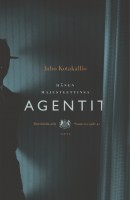 Hänen majesteettinsa agentit. Brittitiedustelu Suomessa 1918–1941
Hänen majesteettinsa agentit. Brittitiedustelu Suomessa 1918–1941
[His Majesty’s agents. British Intelligence in Finland 1918–1941]
Jyväskylä: Atena, 2014. 297 pp., ill.
ISBN 978-952-300-025-4
€34, hardback
Historian Juho Kotakallio’s book deals with the work of the British Intelligence Service (SIS) in Finland from the Declaration of Independence (1917) to the early phase of the Continuation War (1941–1944). The Bolshevik Soviet state was also seen as a threat to Europe in its western neighbour Finland, which offered a key observation post for the gathering of secret intelligence about the Soviet Union. Undercover British agents took up residence in the country, and were moved to and fro across the eastern border. Russian émigrés and some Finns also worked for the British. One victim of the spy world was Sidney Reilly (considered to be a prototype of James Bond), who was lured through Finland to the Soviet Union, where he met his death by execution. In the 1930s the agents’ interest also increasingly focused on economics and on the growing power of Germany. During Finland’s Winter War with the Soviet Union in 1939–40 British intelligence was based more on openness and trust. After the outbreak of the so-called Continuation War, in December 1941, Britain declared war on Finland, and the possibilities for intelligence gathering there became fewer. The book, which gives a fascinating and objective view of the intelligence world, unfortunately lacks an index of names.
Translated by David McDuff
Petri Pietiläinen: Koirien Suomi. Kansanperinnettä ja historiaa [Dogs in Finland. Folk tradition and history]
12 March 2015 | Mini reviews, Reviews
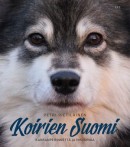 Koirien Suomi. Kansanperinnettä ja historiaa
Koirien Suomi. Kansanperinnettä ja historiaa
[Dogs in Finland. Folk tradition and history]
Helsinki: Finnish Literature Society, 2014. 239 pp., ill.
ISBN 978-952-222-540-5
€32, hardback
Non-fiction writer Petri Pietilä is the author of the award-winning book Koirien maailmanhistoria (‘Dogs in world history’), which deals with the general cultural history of the dog. In the first half of this lively and fascinating new book he discusses the dog in Finnish folk tradition, while in the second half he gives an account of the history of the dog in Finland to the present day. Dogs have been domesticated in the North European region for thousands of years. In folk poetry, such as the national epic, the Kalevala, the dog is first and foremost a house guard and a partner in hunting. In Finnish folk tradition, the dog is viewed more leniently than in other countries, and stories about hellhounds are rare. Yet the attitude towards dogs in Finnish proverbs is not an exclusively positive one. Pietilä also says that the dog’s change of status has been linked to its becoming a helper and beloved pet, and today there are more than half a million of them in Finland. In addition, they are increasingly being used in various work and service roles. The book also presents the six Finnish dog breeds, and includes a dog name day calendar.
Translated by David McDuff
Journey to the first palm tree
16 October 2014 | Fiction, Prose
Teemu is a fat, desperate middle-aged man who’s had it with life – he drives his old Lada to Spain, where he intends to commit suicide by letting himself be trampled to death by bulls in the Pamplona bullrun. (However, there is a chance of this tragedy being cancelled, thanks to a tenacious hitch-hiker, female.) An extract from the novel Särkyvää (‘Fragile’, Tammi, 2014)
When I was seventeen, I yearned to leave behind the small town where I grew up. I heard the owl hooting in the forest: go to Europe.
I heard the dirt-track gravel crunching beneath my shoes: run, lad, run.
The birch in the yard rustled and whispered: if you spend one more summer hanging around the garden of your childhood, you’ll stay here forever.
A frog in the ditch gave a stern croak: look at your father; if you don’t escape you’ll end up an old codger just like him.
Even the smoke twirling up from the sauna chimney spoke to me in billows: I’ll show you the right direction, head south, and don’t stop until you see the first camel. More…
Prize for the best debut book
20 November 2014 | In the news
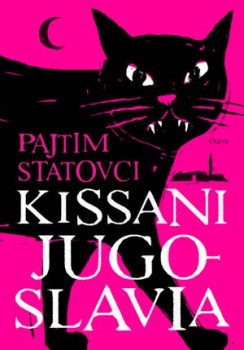 The Helsingin Sanomat literature prize for the best first work, written in Finnish, for 2014 was awarded on 13 November to Kosovo-born Pajtim Statovci, 24, for his novel Kissani Jugoslavia (‘Yugoslavia my cat’, Otava – see translated extracts here).
The Helsingin Sanomat literature prize for the best first work, written in Finnish, for 2014 was awarded on 13 November to Kosovo-born Pajtim Statovci, 24, for his novel Kissani Jugoslavia (‘Yugoslavia my cat’, Otava – see translated extracts here).
The choice was made by a five-strong jury from a total of 65 books. The prize, which was this year awarded for the 20th time, is worth €15,000.
Among the ten finalists were a collection of essays, three collections of poetry and six novels. According to the jury, Statovci’s novel, ‘drowns the reader, after a realistic description of events, in a dreamlike, lyrical vision. This kind of writing is not taught anywhere. The skill either resides in the writer or it doesn’t.’
Luvattu maa. Suur-Suomen unelma ja unohdus [The promised land. The dream of Greater Finland, and how it was forgotten]
26 September 2014 | Mini reviews, Reviews
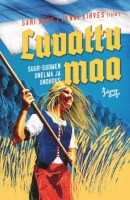 Luvattu maa. Suur-Suomen unelma ja unohdus
Luvattu maa. Suur-Suomen unelma ja unohdus
[The promised land. The dream of Greater Finland, and how it was forgotten]
Toim. [Ed. by] Sari Näre & Jenni Kirves
Helsinki: Johnny Kniga, 2014. 407 p.
ISBN 978-951-0-40295-5
€36.90, hardback
In the 1920s and 1930s Finland was powerfully influenced by the idea of a Greater Finland which was also to include the Finno-Ugric peoples living on the Soviet side of the border – at least East Karelia, if not more. Right-wing nationalists in particular nourished a vision that had its roots in the idealistic ‘Karelianism’ of the nineteenth century. When during the Second World War in 1941 Finland ended up fighting the Soviet Union as an ally of Nazi Germany, and the Finnish army advanced far beyond the eastern border, for a short time many Finns even viewed a Greater Finland as a possibility. After Finland suffered defeat in the war there was a desire to forget both the embarrassing alliance with Nazi Germany and the frenzied nationalistic dreams of Greater Finland with their population resettlements and other plans. Not until the 1970s did anyone begin to study the subject in more depth. Five historians from a younger generation present a fascinating study of the Greater Finland idea and the attempts at its realisation, discussing, for example, the attitude to the war taken by women and the clergy, life at the front line, and propaganda, including its expression in literature.
Translated by David McDuff
You may say I’m a dreamer
25 November 2014 | Fiction, poetry
Prose poems from Tärnornas station – en drömbok (‘The Lucia Maids’ Station – a dream book’‚ Ellips, 2014). Introduction by Michel Ekman
I nurse a very small, perfectly formed child. It’s a girl. She smiles openly at me, even though she is so small. There is no doubt, neither about that nor anything else. The girl is the size of a nib pen, and just as exclusive. The nursing is going very well, it doesn’t hurt, and she can suckle without any problems. We are both at ease and yet awake, not introspective. The girl has intelligent eyes.
The milk keeps flowing.
Nothing runs dry.
Everything is obvious and neither of us is surprised. Just the fact that she is so small. Like a fountain pen. She is swathed in strips of bird cherry white bandages – like the ones mum had in her summer medicine cabinet – a cocoon, a chrysalis, but she’s not cramped, just secure. It smells good around us. I nurse my daughter who is perfect and the right size.
![]()
The many arms of Krishna
14 August 2014 | Extracts, Non-fiction
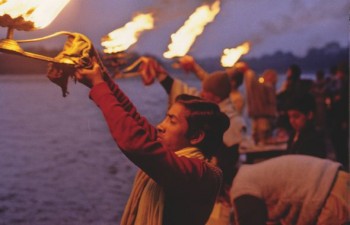
A feast by the Ganges. Photo from Pirjo Honkasalo’s film Atman
Cinematographer, camerawoman and director Pirjo Honkasalo has travelled and filmed widely – Japan, Estonia, India, Chechnya, Ingushetia, Russia – and her documentary films in particular have gained fame. American film critic John Anderson interviews Honkasalo; they talk about her documentary film Atman (1996) about a pilgrimage in India.
Edited extracts from Armoton kauneus. Pirjo Honkasalon elokuvataide (‘Merciless beauty. The film art of Pirjo Honkasalo’, Siltala, 2014; translated from English into Finnish by Leena Tamminen)
You can almost catch a whiff of the Ganges watching Atman [Hindu term, ‘self’], a documentary film in which religious pilgrimage, devotion, exhilaration and hysteria compete with tormented bodies, physical mortification, corpses, pollution and the acrid smoke of ritual cremation for domination of the viewer’s senses. The fact that it won the top prize at the International Documentary Film Festival Amsterdam in 1996 proves there is, if not justice, then good taste in the world. With all due respect to her previous work, Atman signified the full manifestation of Honkasalo’s genius.
What is it about? Eternity. Also, Jamana Lal: a member of the low-caste of Baila, a wifeless, crippled devotee of Lord Shiva whose mother has died, and who must – according to Hindu tradition – take her ashes from the ostensible mouth of the Ganges to the foothills of the Himalayas. More…
Fiat Lux!
31 December 2014 | This 'n' that
 Time for Lux Helsinki light event again: the January 2014 festival (see photos here) brought 150,000 visitors from Helsinki, the rest of Finland and around the world to the city. It is organised by the City of Helsinki.
Time for Lux Helsinki light event again: the January 2014 festival (see photos here) brought 150,000 visitors from Helsinki, the rest of Finland and around the world to the city. It is organised by the City of Helsinki.
The artworks – 17 of them – will be on display in 13 places around the centre of Helsinki, from the courtyard of the Tori Quarters to Finlandia Hall. The light and media artists and sound designers come from Finland, Germany, France, Belgium and Japan.
Lux Helsinki is also part of as the International Year of Light and Light-based Technologies of the United Nations in 2015.
Darkness will slowly diminish, and there will be more light: it’s great that Helsinki winter – at times white with snow, at times not – will again (thanks to artists and the latest technology) be filled with colour for a while. Let light be made!
Aho & Soldan: Helsinki 1950-luvun väreissä / Helsingfors in 1950-talets färger / Helsinki in 1950’s colours
11 January 2015 | Mini reviews, Reviews
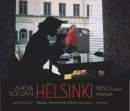 Aho & Soldan: Helsinki 1950-luvun väreissä / Helsingfors in 1950-talets färger / Helsinki in 1950’s colours
Aho & Soldan: Helsinki 1950-luvun väreissä / Helsingfors in 1950-talets färger / Helsinki in 1950’s colours
Teksti / text: Eino Leino
Translation into Swedish by Marjut Hökfelt, into English by Elina Adams
Helsinki: Gummerus, 2014. 168 pp., ill.
ISBN 978-951-20-9527-8
€36.90, hardback
The photographer Claire Aho (born 1925) is the granddaughter of the author and journalist Juhani Aho (1861–1921) and his artist wife Venny Soldan-Brofeldt. Two of Aho’s sons, Heikki and Björn, became photographers and documentary film producers, founding the company Aho & Soldan. In the 1940s Heikki’s daughter Claire began to work for Aho & Soldan and becme a well-known fashion photographer. She also began photographing her native Helsinki; in 1952 she was assigned to film the Helsinki Summer Olympics. She continued her collaboration with Pathé News until the early 1960s. Colour came, literally, into the picture after the war; the photographs in this book feature life in the 1950s Helsinki. The photographs in their gently faded colours of the still small city, its inhabitants, parks, buildings and monuments are taken by either the two brothers or Claire Aho – in their time they were all signed just by Aho & Soldan. In his essay journalist Eino Leino portrays life in the city that he remembers from his own childhood in the post-war era, which to today’s reader appears sweetly idyllic, somehow optimistic and peaceful; the city has changed greatly – and yet stayed the same.
Kaisa Koivisto & Uta Laurén: Suomalaisen taidelasin kultakausi [The golden era of the Finnish glass]
19 March 2015 | Mini reviews, Reviews
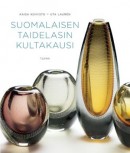 Suomalaisen taidelasin kultakausi
Suomalaisen taidelasin kultakausi
[The golden era of the Finnish glass]
Helsinki: Tammi, 2014. 326 pp., ill.
ISBN 978-951-31-7320-3
€49.90, hardback
The authors of this book specialise in Finnish glass and its history, working at the Finnish Glass Museum. The 1950s and the early 1960s formed the golden age of Finnish glass: young artists such as Timo Sarpaneva, Tapio Wirkkala, Gunnel Nyman, Nanny Still and Kaj Franck all began gaining fame as the number of prizes won at the 1950s Milan triennales made way for their international success. Finnish glass factories worked closely with artists, as serial production had to provide the commercial success. In the 1970s, however, the glass industry began to diminish due to heavy competition in the form of imported glassware. Unique objects of glass are still made and glass artists trained in Finland, but of six major factories only Iittala (est. 1881) is still working; for example, the 220-year old Nuutajärvi Glass Factory closed its doors in 2013. The majority of the excellent photographs in this comprehensive, beautiful book are from the Finnish Glass Museum or the Finnish Design Museum. The book includes short biographies of 27 Finnish glass artists and histories of glassworks as well as a glossary of glass-making terms.
Minna Lindgren: Ehtoolehdon pakolaiset [The refugees of Twilight Grove]
26 March 2015 | Mini reviews, Reviews
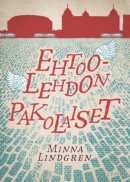 Ehtoolehdon pakolaiset
Ehtoolehdon pakolaiset
[The refugees of Twilight Grove]
Helsinki: Teos, 2014. 334 pp.
ISBN 978-951-851-584-8
€29.90, paperback
This is the second volume of a novel trilogy by the writer and music editor Minna Lindgren (born 1963). The protagonists in Kuolema Ehtoolehdossa (‘Death in Twilight Grove’, 2013) were ladies in their nineties in an assisted living facility in Helsinki – administered by a foundation entitled (ironically enough), ‘Care and Love of the Elderly‘. Lindgren’s ‘adventure satire’ continues to focus on the lack of common sense, respect and empathy (as well as presence or interest of relatives) in the – often patronising – care of the elderly. The story revolves round the evacuation of the inhabitants from the facility to temporary housing as a tragicomically huge renovation project sets off, not without some seriously fishy business. This volume might be described as a slightly more sombre in its themes than the previous one, as illnesses and death occur – however, the point is that dying, not an unexpected turn in a person’s life after the age of 90, should be regarded as something natural. As what Lindgren writes about is by no means a phenomenon foreign to contemporary western societies, it is not surprising that so far the translation rights of the trilogy into eight languages have been sold.
‘The Lion of the North’ wins the non-fiction Finlandia Prize
25 November 2014 | In the news
The Finlandia Prize for Non-Fiction 2014, worth €30,000 and awarded by Suomen Kirjasäätiö (The Finnish Book Foundation), went to the historian and author Mirkka Lappalainen on 19 November for her book on a 17th-century Swedish king.
Finlandia Prize for Non-Fiction 2014, worth €30,000 and awarded by Suomen Kirjasäätiö (The Finnish Book Foundation), went to the historian and author Mirkka Lappalainen on 19 November for her book on a 17th-century Swedish king.
The winning entry, entitled Pohjolan leijona, Kustaa II Adolf ja Suomi 1611–1632 (‘The Lion of the North. Gustavus II Adolphus and Finland 1611–1632’, Siltala), was chosen by from a shortlist of six finalists by Heikki Hellman, journalist and Dean of the School of Communication, Media and Theatre in Tampere. According to him, ‘Pohjolan leijona is an exceptionally well-written narrative for a non-fiction book; the author uses both earlier literature and numerous primary and secondary sources with great skill. Lappalainen succeeds in demonstrating how, during the reign of Gustavus II Adolphus, both Sweden and its easterly province, Finland, began to develop an organised society with its structure of officials and bureaucracy, how jurisdiction replaced the arbitrary rule of the aristocracy and how it was only then that Finland developed its role as part of Sweden. Pohjolan leijona sweeps the reader along and helps us to understand where we have come from and who we are.’
Hellman also commented on the growing practice of publishing non-fiction texts in English only: ‘Research is not done only for other scholars; it must also be relevant to people’s lives and be brought to their attention. We must also publish in our mother tongue, or else it will not survive as a language for research. This is one of the reasons why non-fiction is so necessary.’
Mirkka Lappalainen has received other prizes for her work. Susimessu (‘Wolf mass’), for example, was voted History Book of the year in 2010.
Life: facts and fiction
10 September 2014 | Extracts, Non-fiction
 In his latest book, the architect and author Arne Nevanlinna (born 1925) recalls, among other things, his Helsinki childhood and family, the wartime period, his fellow architect Alvar Aalto, various aspects of the spirit of the times, his own work and writings. His first novel Marie was published in 2008. Extracts from Arne. Oman elämän kintereillä (‘Arne. On the trail of one’s life’, Siltala, 2014)
In his latest book, the architect and author Arne Nevanlinna (born 1925) recalls, among other things, his Helsinki childhood and family, the wartime period, his fellow architect Alvar Aalto, various aspects of the spirit of the times, his own work and writings. His first novel Marie was published in 2008. Extracts from Arne. Oman elämän kintereillä (‘Arne. On the trail of one’s life’, Siltala, 2014)
My attitude to my own identity has developed from the unconsciousness of childhood, the uncertainty of early adulthood, the artificial arrogance of middle age and the self-analysis of approaching retirement, to my present situation.
Despite the fact that my first book had some degree of success, it took many books before I felt I was a real writer. The process continued for well over ten years, by which time I was already over eighty. Before that, I thought of writing as a way to pass the time and combat loneliness. I imagined that I was writing for a living, and that I lived in order to write. I was in the fortunate position of not to think about my income.
Even then, I knew that this was just a catchphrase for the event that it occurred to someone in the audience to ask me why I wrote. That never actually happened. No wonder, as both question and answer would have been unnecessary, to put it mildly, and stupid, to put it harshly. More…
Hannu Rautkallio: Mannerheim vai Stalin. Yhdysvallat ja Suomen selviytyminen 1939–1944 [Mannerheim or Stalin. The United States and Finland’s survival 1939–1944]
2 April 2015 | Mini reviews, Reviews
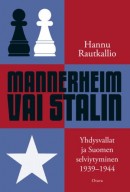 Mannerheim vai Stalin. Yhdysvallat ja Suomen selviytyminen 1939–1944
Mannerheim vai Stalin. Yhdysvallat ja Suomen selviytyminen 1939–1944
[Mannerheim or Stalin. The United States and Finland’s survival 1939–1944]
Helsinki: Otava, 2014. 463 pp., ill.
ISBN 978-951-1-27394-3
€39.70, hardback
In his book political historian Hannu Rautkallio explores American attitudes towards Finland during the Second World War, when the country fought a Winter War and Continuation War against the Soviet Union. He makes use both of older materials and of American documents that have only become accessible to researchers in the 2010s. During the war years two trends were dominant; one was sympathetic to the aims of the Soviet Union, while the other took a hostile view of them. The US political leadership had refused to support Finland in the Winter War, but as the World War progressed the United States tended to understand the small country’s objectives and also the special nature of its alliance with Germany. The two states shared intelligence and there were a large number of secret contacts with Finland’s top government leadership. At the end of World War II, the United States communicated to the Soviet Union, which was dictating peace terms to Finland, that it was important Finland should remain an independent state. Rautkallio’s account keeps branching out along interesting side-tracks, but the book’s central theme captures the reader’s interest.

